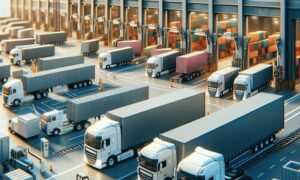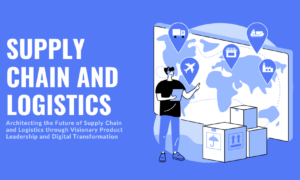The supply chain industry is notoriously unpredictable. Changing factors like the weather, labor availability and fluctuating fuel costs pose challenges for companies trying to get their products from point A to point B.
But new technologies are helping to mitigate those risks at every step of the process. Let’s look at how companies use technology to transition from a reactive stance on mitigating supply chain risk to a proactive one.
Early Warning and Predictive Analytics
Predictive analytics tools are being used to anticipate risks before they occur. For example, a company may use predictive analytics software to identify any possible issues in the supply chain and take action before they can cause harm. Such supply chain risk management software uses historical and real-time data about events to create a model for mitigating risks.
The software uses algorithms to analyze a massive chunk of data, which then helps make predictions. For example, the supply chain risk management system can predict events like equipment failure or natural disasters before they occur. Once these predictions have been made, you can use them as an early warning system to know how best to respond if disaster strikes.
Similarly, the systems can also help identify the financial, legal, human error, etc., types of supply chain risks based on data. For example, the systems can ingest historical data to determine the most common events where financial losses occurred in the past. Based on the insights, you can avoid making the same mistakes and prevent losses.
Visualization of Operational Processes
Visualization of operational processes is another huge asset in supply chain risk management. Visualization can be used to improve efficiency, quality, and employee engagement. When employees clearly understand how the process works, they will have more confidence in their ability to perform well. Strong empowerment will further help reduce turnover rates and improve overall morale.
If your business has an online presence, you should consider setting up some visualization tools for your consumers. This is especially important if you sell high-priced products or services requiring special care during delivery or installation.
You may also want to consider setting up a visualization tool for yourself to understand better where your company stands regarding compliance standards like ISO certifications. This way, if there are any issues with compliance on your end, it’ll be easier for everyone involved because everyone knows where they stand!
Contractual Compliance and Supply Chain Visibility
Contractual compliance is essential for business. In fact, it’s become such a concern that the Financial Stability Board (FSB) has established standards and best practices to help mitigate risk on a global scale.
But what does this mean for your business? How does contractual compliance and supply chain visibility affect you?
For starters, contractual compliance helps manage risk. These agreements outline expectations between suppliers and customers, so both parties know what they have to do to satisfy their end of the bargain. This can include anything from product quality requirements to delivery deadlines—and there are many other areas where contractual agreements factor into risk management strategies.
When all goes according to plan and everyone sticks with their agreed-upon obligations, there is less opportunity for an issue like supplier failure or late shipment delays. Hence, it leads to fewer wasted resources at every stage along your supply chain process!
Low-Cost Sensing and Monitoring
The development of low-cost sensors and data logging systems has made it possible to observe previously impossible things to measure. Sensors can monitor temperature, pressure, humidity, vibration, and other metrics. They can also be used to track the location of goods in the supply chain.
In addition to these physical measurements at rest points along the supply chain, some companies are exploring ways to use this technology on moving objects such as trucks or trains.
For example, one company I spoke with uses sensors on its vehicles that automatically detect any mechanical issues before they occur by monitoring engine functions such as RPMs and oil temperature while driving down the highway at a steady speed of 65 miles per hour.
Suppose an issue is detected early enough through machine learning algorithms trained on historical data from similar vehicles. In that case, alerts are sent out immediately so technicians can fix them before they become customer problems later down the line.
Robotic Automation
One of the most common ways technology is used to mitigate risks in supply chains is through robotics. Robotic automation refers to using robots in manufacturing processes, which can reduce risks related to human error, injury, and damage. Here are some examples:
Human Error
Robots can perform tasks with high accuracy and consistency that humans cannot achieve. This reduces the risk that mistakes or errors will occur during production. For example, suppose you have an assembly line of workers performing identical steps on an assembly line. In that case, each worker may make different mistakes as they go along due to fatigue or other factors such as boredom or stress levels.
By using a robot instead of a person for this task, you eliminate much of the human error involved in performing those same actions over and over again repeatedly throughout your business’s operations cycle every day for years at a time.
Human Injury
Human injury at the workplace is a common thing. According to National Security Council (NSC), the costs of workplace-related injuries were $163.9 billion in 2020. Labors working in the manufacturing plant and logistics are at the most risk of injuries as they have to do the heavy lifting.
Robots can help solve this issue by doing the heavy work while allowing laborers and employees to focus on something more substantial. Without human intervention, AI-based robots can even navigate the workplace to shift containers and other items.
Damage
Another significant risk that leads to waste and financial losses in the supply chain is damage. There are various situations where damage may occur, such as while manufacturing, shifting items, or on delivery. Again, robots can help by eliminating errors that can lead to damage.
Conclusion
New technologies are helping to mitigate risks in all aspects of the supply chain. The key is to be proactive, as opposed to reactive, in dealing with threats. With this approach, companies can take swift action when something goes wrong, which will help prevent losses that may affect an entire organization.



































